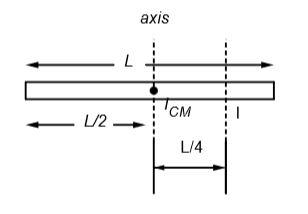
Moment of inertia of a thin rod of mass m and length l about at axis passing through a point $ \dfrac { l }{ 4 }$ from one and perpendicular to the rod is:
$A. \dfrac { m{ l }^{ 2 } }{ 12 }$
$B. \dfrac { m{ l }^{ 2 } }{ 13 }$
$C. \dfrac { 7m{ l }^{ 2 } }{ 48 }$
$D. \dfrac { m{ l }^{ 2 } }{ 9 }$
Answer
576k+ views
Hint: Use the theorem of parallel axes. Substitute the values in the formula and get a moment of inertia of a thin rod of mass m and length l about at the axis passing through a point $ \dfrac { l }{ 4 }$ from one and perpendicular to the rod.
Formula used:
$I ={ I }_{ CM } + m{ d }^{ 2 }$
Complete answer:

Given: $d= \dfrac { l }{ 4 }$
According to the theorem of parallel axes,
$I= { I }_{ CM } + m{ d }^{ 2 }$ …(1)
where, I: Moment of inertia of thin rod
${ I }_{ CM }$: Moment of Inertia at center of mass
But, we know ${ I }_{ CM } = \dfrac { 1 }{ 12 } m{ l }^{ 2 }$
Therefore, substituting the values in the equation. (1) we get,
$I = \dfrac { 1 }{ 12 } m{ l }^{ 2 } + m{ \left( \dfrac { l }{ 4 } \right) }^{ 2 }$
$\therefore I = \dfrac { m{ l }^{ 2 } }{ 12 } + \dfrac { m{ l }^{ 2 } }{ 16 }$
$\therefore I= \dfrac { 7m{ l }^{ 2 } }{ 48 }$
Therefore, Moment of inertia of a thin rod of mass m and length l about at axis passing through a point $ \dfrac { l }{ 4 }$ from one and perpendicular to the rod is $I = \dfrac { 7m{ l }^{ 2 } }{ 48 }$.
So, the correct answer is “Option C”.
Note:
For a uniform rod with negligible thickness, the moment of inertia about its center of mass is ${ I }_{ CM } = \dfrac { 1 }{ 12 } m{ l }^{ 2 }$. And the moment of inertia about the end of the rod is ${ I }_{ end } = \dfrac { 1 }{ 3 } m{ l }^{ 2 }$.
Formula used:
$I ={ I }_{ CM } + m{ d }^{ 2 }$
Complete answer:

Given: $d= \dfrac { l }{ 4 }$
According to the theorem of parallel axes,
$I= { I }_{ CM } + m{ d }^{ 2 }$ …(1)
where, I: Moment of inertia of thin rod
${ I }_{ CM }$: Moment of Inertia at center of mass
But, we know ${ I }_{ CM } = \dfrac { 1 }{ 12 } m{ l }^{ 2 }$
Therefore, substituting the values in the equation. (1) we get,
$I = \dfrac { 1 }{ 12 } m{ l }^{ 2 } + m{ \left( \dfrac { l }{ 4 } \right) }^{ 2 }$
$\therefore I = \dfrac { m{ l }^{ 2 } }{ 12 } + \dfrac { m{ l }^{ 2 } }{ 16 }$
$\therefore I= \dfrac { 7m{ l }^{ 2 } }{ 48 }$
Therefore, Moment of inertia of a thin rod of mass m and length l about at axis passing through a point $ \dfrac { l }{ 4 }$ from one and perpendicular to the rod is $I = \dfrac { 7m{ l }^{ 2 } }{ 48 }$.
So, the correct answer is “Option C”.
Note:
For a uniform rod with negligible thickness, the moment of inertia about its center of mass is ${ I }_{ CM } = \dfrac { 1 }{ 12 } m{ l }^{ 2 }$. And the moment of inertia about the end of the rod is ${ I }_{ end } = \dfrac { 1 }{ 3 } m{ l }^{ 2 }$.
Recently Updated Pages
Master Class 11 Economics: Engaging Questions & Answers for Success

Master Class 11 English: Engaging Questions & Answers for Success

Master Class 11 Social Science: Engaging Questions & Answers for Success

Master Class 11 Biology: Engaging Questions & Answers for Success

Class 11 Question and Answer - Your Ultimate Solutions Guide

Master Class 11 Business Studies: Engaging Questions & Answers for Success

Trending doubts
10 examples of friction in our daily life

One Metric ton is equal to kg A 10000 B 1000 C 100 class 11 physics CBSE

Difference Between Prokaryotic Cells and Eukaryotic Cells

1 Quintal is equal to a 110 kg b 10 kg c 100kg d 1000 class 11 physics CBSE

State the laws of reflection of light

Explain zero factorial class 11 maths CBSE




